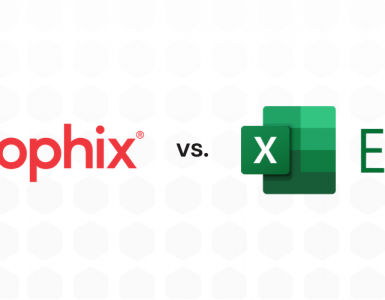In 2020, the construction industry faced many different challenges. Each state had differing government regulations, travel restrictions disrupted supply chains, and new safety guidelines impacted worksite productivity.
As the business world moves towards more agile project management in 2021, contractors need to focus on their resources – people and equipment. Constant shifts in the construction industry mean that contractors need to constantly reforecast and adjust plans to effectively manage the availability of skilled workers and equipment.
We sat down with Marcum LLP construction expert, Chuck Schwartz, and Chris Porter, Construction Manager at Prophix, to discuss the challenges of resource management in the age of COVID-19 and expectations for recovery.

Chuck Schwartz |
Chris Porter |
1. What are some of the resourcing challenges that you think are carrying over from COVID-19?
Chuck: A significant challenge was those businesses that use local server-based software systems (a.k.a. “in-house”) versus those that use accounting and business management software in the cloud. Those that use cloud software saw no significant delays or downtime, versus those that had to scramble to set up computers to be able to connect to their systems. Then, of course, with the office closures and lockdowns, important processes like system backups weren’t performed regularly, if at all.
Chris: As so many of us know, labor shortages have been an ongoing issue in the construction industry for some time now. Much like a lot of things, COVID has only magnified this issue. However, it’s not just labor that will continue to be a challenge. Materials and equipment are also in high demand, and prices have risen considerably in both areas due to production slowdowns, amongst other things. This disruption will no doubt continue onwards for some time until production and supply levels can return to what they were pre-pandemic.
2. Based on the challenges mentioned above, what areas do you think construction companies should invest in to prepare for potential future disruptions? (i.e., software, scholarships, or trade programs to train new talent, safety protocols, education for project managers, etc.)
Chuck: There’s an old saying – do things in good times, so you are not scrambling in the bad times. And while these are certainly not quite the good times (at least not yet anyway), think back to just before the lockdown – we had good times. But then, I heard things like, “we are too busy to think about that now,” and other excuses for not doing some of the important things in the good times.
So, if we learned anything from the lockdown is that life is unpredictable, and things can happen at any time. Taking care of the important things and the difficult things before disaster strikes is key.
Chris: Chuck makes many good points here. Proactively investing in the right areas of your business will set you up for success down the road, no matter what challenges you’re faced with. It’s always nice to relish the good times, but organizations must think strategically about investing in their people, technology, and processes.
On the technology side, construction companies use many different technologies to run their business. ERP, Estimating, Project Management, CRM, and Payroll software are just a few. You need all these systems to run your business and make decisions, but it’s tedious to jump from one system to the next to get the answers you need. Contractors should be investing in a data strategy and technology that pulls all their data together. This makes it possible for innovative contractors to see and respond to issues as they arise. Contractors should be able to easily model the impact of project delays, equipment or labor shortages, and the resulting cash flows across the entire business.
3. Are there any technology solutions that you think contractors would benefit from investing in, or if they already have, look for ways to utilize more?
Chuck: Aside from cloud CPM software, I would say an integrated construction ERP software. What I mean by this is that most construction accounting systems have always done a very good job at accounting, job costing, and financial reporting, but I am also seeing wonderful advancements made in the project management and document control side of things. Most of the contractors I speak with would prefer one system to manage their entire business, from accounting and back office, to project management, and out to the field.
What I’ve seen recently from system vendors like Viewpoint is very impressive and eliminates the need for third-party project management systems. I will also share that what I’ve seen from Prophix and how they work with ERP systems to offer advanced opportunities for financial and statistical reporting is very impressive. CPM software is valuable to contractors who deal with things like PPP, ERC, and other reporting and forecasting needs.
Chris: I completely agree with Chuck that without an integrated construction ERP software like Viewpoint, you’re not running your business as efficiently as you could be. However, I believe that this is only half the puzzle.
You might feel burnt out after a long ERP implementation and think that’s it – but there’s more. Now, you have to consider how you’re going to consume all that great information. At the end of the day, relational data systems like ERPs are primarily meant for logging and storing large sets of data. Getting that data out and into a consumable and easy-to-understand format is where you will start to gain competitive advantages in the marketplace and make better decisions.
4. What areas of focus do you think contractors should be looking into regarding scheduling and staffing because of COVID restrictions?
Chris: One of the lessons I think we have all learned from this pandemic is that our situation can change at the drop of a hat. In many ways, this isn’t anything new to construction professionals who deal with scheduling changes on jobs all the time. What matters is your ability to understand where and when you can make changes to your scheduled labor and equipment ahead of time.
Being able to reforecast your staffing levels and equipment usage well in advance will result in better utilization and margins on those key assets. So, the question we should be asking ourselves is, can I do this today? Moreover, can I report on my required, scheduled, and actual resource hours daily? This is where a data strategy comes into play. Connecting these 3 datasets is imperative, and thankfully, Prophix has a purpose-built solution to make this possible.
5. What should contractors be prepared for in 2021 once the vaccine has become more widely available?
Chris: In speaking with several sureties and accounting partners, there has already been an increased focus on cash management and financial health. Everyone is asking for more regular 13-week cash projections and updates on key performance indicators, such as days of cash and other liquidity ratios.
Knowing this will likely continue in the foreseeable future, contractors need to consider the processes they have for putting this data together for stakeholders. Are you spending days and days getting this data out of various systems and crunching it in Excel? A bank or surety will have a lot more confidence if you’re able to show them the solid foundation upon which you have produced these numbers. Corporate Performance Management solutions, such as Prophix, provide contractors with the automation, scale, and best practices that Excel can’t offer. Out-of-the-box dashboards, coupled with a library of KPIs, can give contractors insight into the health of their business almost instantly.
To learn more about resource management, watch our on-demand presentation, Navigating Challenges and Strategies Related to Construction Claims During a Pandemic, with Marcum, Viewpoint, and Prophix.







